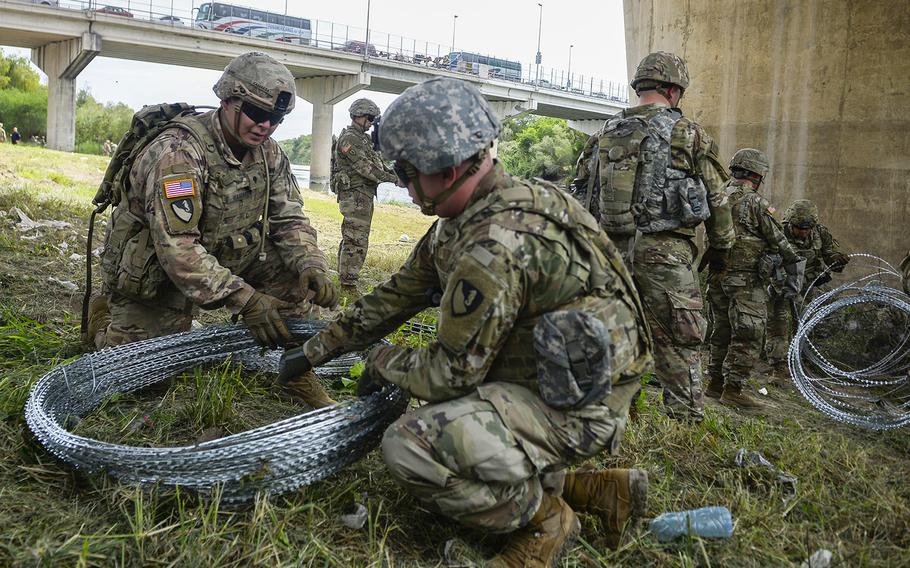
Soldiers from the 97th Military Police Brigade, and 41st Engineering Company, Fort Riley, Kansas, work with U.S. Customs and Border Protection at the Hidalgo, TX., port of entry, applying 300 meters of concertina wire along the Mexico border in support of Operation Faithful Patriot, November 2, 2018. (Alexandra Minor/U.S. Air Force photo)
WASHINGTON – Thousands of active-duty troops are bolstering temporary barriers along the U.S.-Mexico border and training at nearby logistics hubs for issues that could arise as they support Customs and Border Protection agents protecting against immigration from Central America, a department spokesman said Monday.
However, Army Col. Rob Manning, one of the Pentagon’s top spokespeople, declined to describe in detail the nature of the training at established military bases in California, Texas and Arizona. He also declined to detail the rules for the use of force for troops supporting Operation Faithful Patriot, just days after President Donald Trump announced he had instructed the military that if people throw rocks to “consider it a rifle.”
“The [training] vignettes cover a range of scenarios that could occur,” Manning told reporters Monday. “But … we don’t anticipate that there will be that type of interaction” with migrants crossing the border illegally or seeking asylum.
By Monday, some 4,800 active-duty troops had arrived at the 13 logistics hubs that the Pentagon established to support the mission. Manning said the deployment would grow to 5,200 by Monday evening and more than 7,000 troops in the near future. The deployment of active-duty soldiers is in addition to roughly 2,100 National Guard troops deployed to the U.S.-Mexico border region since April to support CBP agents under the umbrella of a separate operation.
The deployment comes as a so-called caravan of some 3,500 Central American migrants arrived in Veracruz, Mexico on Sunday, some 600 miles for the U.S. border, according to The Associated Press. Leading up to Tuesday’s midterm elections, Trump has repeatedly described the group as a national security threat that includes “unknown Middle Easterners” and “fighters.” However, AP reporters traveling with the group have reported it is primarily made up of women and children who have said they seek asylum after fleeing violence in their home countries.
On Thursday, Trump warned the migrants that the military would be prepared to treat rock-throwing the same as wielding a rifle. On Friday, the president insisted he did not intend to imply individuals who throw rocks would be shot dead.
Manning downplayed concerns that American troops would be forced to use their weapons during the deployment. The troops are barred by federal law and Pentagon policy from performing any law enforcement function. By the nature of the mission, military forces are not expected to interact with migrants, Manning said.
“Our soldier always have the inherent right of self-defense,” he said. “They are well-trained, they are disciplined and they are proficient. … [When] they have to make a judgement call, our soldiers are disciplined to make the right call.”
Only military police officers will be armed during the operation, Manning said. The colonel could not provide the size of the MP force deploying. However, he said they would be tasked with providing security to other military troops conducting operations such as placing temporary barriers or razor wire along the fence, building temporary structures for CBP agents, ferrying CBP officials by helicopter throughout the region or providing medical support.
The Pentagon determined it would use active-duty troops for the new mission, said Tom Crosson, another Defense Department spokesman. Earlier Monday, Manning had said the Homeland Security Department had requested the use of active-duty troops. Manning did not answer questions about why active-duty troops were preferred over the National Guard. For decades, the Guard has taken on much of the burden when military troops were needed in the United States.
Manning said the large-scale deployment of active-duty troops, the largest single movement of forces since Defense Secretary Jim Mattis took office in January 2017, would not hurt combat readiness.
“We are an agile military,” he said. “We will adjust to make sure our readiness does not atrophy and we meet our global commitments.”
Meanwhile, the Pentagon had not determined the cost of the deployment as of Monday, Manning said.
The Department of Defense will foot the bill for the operation, even as the military troops deploying are doing so only at the request and in support of the Homeland Security Department. Manning declined to comment further on the funding for the mission, saying that Pentagon Comptroller David L. Norquist was preparing a cost estimate.
dickstein.corey@stripes.com Twitter: @CDicksteinDC